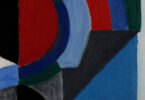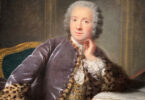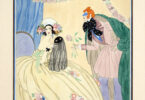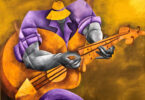
Théo van Rysselberghe. If you were to look him up, this is what you would find written in half a dozen web entries, including WikiArt: “Théophile ‘Théo’ van Rysselberghe (23 November 1862 – 14 December 1926) was a Belgian neo-impressionist painter, who played a pivotal role in the European art scene at the turn of the century.” But unlike contemporary friends such as Toulouse-Lautrec, Camille Pissarro, and Paul Signac, van Rysselberghe’s name is hardly known to any but a few art lovers.
Part of the reason for this near anonymity is the fact that the vast majority of his work remains in private collections; they can rarely be seen in person unless they’re out on loan. Further, after extensive Google and Yahoo searches, one finds that there have been only a handful of retrospective shows of this “pivotal artist” within the past twenty years —all of them held at modestly-sized art museums or galleries. Yet, every encyclopedia waxes quixotic about his “brilliance” and his “importance.”
My interest in van Rysselberghe began at the Portland Art Museum where one work —a pointillist beauty from 1900 called Plage à marée basse à Ambleteuse, le soir (Beach At Low Tide, Ambleteuse, Evening)— caught my eye. About a month after that encounter, another work —on loan from an anonymous private collection— was shown at the Museum for a few weeks: Trois enfants en bleu (Three Children in Blue). It bowled me over. Who was this artist? I needed to know.
Born in Ghent into a bourgeois French-speaking family, van Rysselberghe proved to be a born artist, studying at such prestigious institutions as the Royal Academy of Fine Arts in Brussels where he developed an impressionist style. Between 1882 and 1888, the twenty-something painter —influenced by his teacher Jean-Francois Portaels —journeyed three times to Morocco where he spent months at a time absorbing the local culture and creating picturesque scenes of street-life, the kasbah, and the local bazaars, including Arab Street Cobblers (1882).
It was during this same period that he became one of the principal co-founders of the Belgian artistic circle called Les XX, a group whose membership would eventually include such luminaries as James Ensor and Odilon Redon. They hosted ten annual shows in Brussels between 1884 and 1893 (one of which, in 1891, was the first retrospective show of Van Gogh’s paintings) that also featured literary lectures and concerts by some of the leading composers of the day, including César Franck, Nikolai Rimsky-Korsakov, and Gabriel Fauré.

After several years of experimenting with the lighting techniques of impressionists like Monet and Renoir, van Rysselberghe discovered the paintings of Georges Seurat during a visit to Paris on a “field trip” to find new talent for a Les XX exhibition in 1887. Although Seurat’s now legendary La Grande Jatte was poorly received at the Les XX show, for von Rysselberghe, that painting proved to be a catalyst; he abandoned impressionism and delved fully into pointillism.
His extraordinary 1888 blue and gold Portrait of Alice Sethe —now on display at the Musée départemental du Prieuré, in Saint-Germain-en-Laye, France— was a turning point. This enormous work, measuring 8 feet by 16 feet (492 x 245 cm), became his calling card, and from the late 1880s until around 1910, he vividly experimented with the dots and dashes of the pointillist method even when he was beginning to regularly incorporate other techniques.
A year after the success of the Alice Sethe painting, he married Maria Monnom and together they had a daughter, Elisabeth, who became famous in her own right as a translator —not to mention as the mistress of such literary luminaries as Rupert Brooke and André Gide. That, as they say, is a fascinating story for another time.
The van Rysselberghes moved to Paris in 1897, where Theo contributed to an anarchist magazine Les Temps Nouveaux with fellow artists Paul Signac and Camille Pissarro among others and spent significant time scouting around for new artists to support and promote. During one such search in the early 1900s, he famously decided against some paintings that he found to be “ugly and uninteresting.” The artist? Pablo Picasso—who was immersed in his “Blue Period” at the time. It was a decision van Rysselberghe would later rue.

At the turn of the century, he began applying broader, more fluid and flexible brush strokes onto his canvases. The Reading Room from 1903 —a large group portrait measuring nearly 6 by 8 feet (181 x 241 cm)— is an excellent example of this shift in style, one still rooted in pointillism, but beginning to show the influence of other painters, including Van Gogh, whose work he found engrossing. He had invited the Dutch artist to exhibit at the 1890 Les XX show, and it was there that The Red Vineyard was purchased by painter Anna Bach—the only painting Van Gogh ever sold in his lifetime.
What a web search will also show is that through his entire career, in addition to the paintings, he also produced superb charcoal and pastel drawings, including several self-portraits and depictions of his wife. Like his oils, these drawings reveal the progression from pointillism towards a relaxed use of line and shading reminiscent of John Singer Sargent’s work.

His brother, the well-regarded architect Octave van Rysselberghe, built him a spacious residence on the Côte d’Azur in 1911, and the artist moved there permanently, far from the Parisian and Brussels art scenes. Here —until his death in 1926—websites of other major museums in Europe, Asia, and the Americas will prove fruitless and frustrating. Why this is so remains a mystery. Fortunately, the internet allows access to over 200 pieces. Granted, it’s not the same as seeing a painting or drawing “in person,” but it does give you a glimmer of a noteworthy artist who lived up to the name “pivotal” —truly an artist we should know. G&S





Leave a Comment